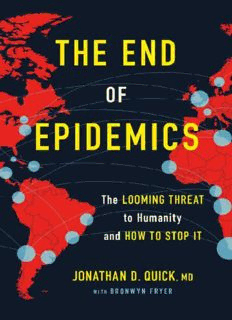
The End of Epidemics: The Looming Threat to Humanity and How to Stop It PDF
Preview The End of Epidemics: The Looming Threat to Humanity and How to Stop It
Begin Reading Table of Contents About the Authors Copyright Page Thank you for buying this St. Martin’s Press ebook. To receive special offers, bonus content, and info on new releases and other great reads, sign up for our newsletters. Or visit us online at us.macmillan.com/newslettersignup For email updates on Dr. Jonathan D. Quick, click here. For email updates on Bronwyn Fryer, click here. The author and publisher have provided this e-book to you for your personal use only. You may not make this e-book publicly available in any way. Copyright infringement is against the law. If you believe the copy of this e-book you are reading infringes on the author’s copyright, please notify the publisher at: us.macmillanusa.com/piracy. Please note that some of the links referenced throughout this work are no longer active. To the memories of Dr. D. A. Henderson, a tenacious and ultimately victorious leader in the battle to end the scourge of smallpox. and Nurse Salome Karwah, an Ebola survivor who saved many lives and later was left to die in childbirth, a victim of stigma. Unless otherwise specified, all dollar amounts are U.S. currency. ACRONYMS ACLU American Civil Liberties Union ACT UP AIDS Coalition to Unleash Power ADDO Accredited Drug Dispensing Outlet AIDS Acquired Immune Deficiency Syndrome BSE bovine spongiform encephalopathy BSL Biosafety Level CAFO Concentrated Animal Feeding Operations CDC Centers for Disease Control and Prevention (U.S.) DDT dichlorodiphenyltrichloroethane DNA deoxyribonucleic acid EIS Epidemic Intelligence Service FAO Food and Agriculture Organization of the United Nations Group of 7 G7 Group of 20 G20 GAO United States Government Accountability Office GDP gross domestic product GHSA Global Health Security Agenda GPHIN Global Public Health Intelligence Network GRID Gay Related Immune Deficiency HIV human immunodeficiency virus IHR International Health Regulation ISIS Islamic State in Iraq and Syria MERS Middle East Respiratory Syndrome MERS Middle East Respiratory Syndrome MBM meat and bone meal MMR measles mumps rubella MRSA Methicillin-resistant Staphylococcus aureus MSF Médecins Sans Frontières (in English, Doctors Without Borders) MSH Management Sciences for Health NGO nongovernmental organization NIH National Institutes of Health (U.S.) PEF Pandemic Emergency Financing PEPFAR President’s Emergency Plan for AIDS Relief (U.S.) PHEIC Public Health Emergency of International Concern R&D research and development SARS severe acute respiratory syndrome SMAC Social Mobilization Action Consortium TAC Treatment Action Campaign UNAIDS Joint United Nations Programme on HIV/AIDS UNICEF United Nations Children’s Fund USAID United States Agency for International Development USDA U.S. Department of Agriculture vCJD Creutzfeldt–Jakob (mad cow) disease WHO World Health Organization PROLOGUE A FEAR I’D NEVER FELT BEFORE What can be done to stop the next killer virus from destroying millions of lives? Following a frightening meeting with my staff at the peak of the West Africa Ebola crisis, I asked myself, “What would it take to prevent such devastating epidemics?” A new pandemic could kill more than 300 million people worldwide. It could also reduce global GDP by 5 to 10 percent—an impact equivalent to the financial crisis of 2008. There will always be new outbreaks of infectious diseases. But as a medical doctor and a global health leader, I know that by following the prescriptions laid out in this book, it is within the power of modern public-health leaders to keep such outbreaks from exploding into catastrophic epidemics that kill thousands or millions. I was more alarmed than I had ever been in my 35 years of working in public health. The world was facing a potentially global catastrophe unlike anything I, or any of my colleagues, had ever seen. In response to the fears of my far-flung staff, I knew I had to be straightforward and talk frankly and calmly about the crisis. It was a rainy Thursday morning, October 9, 2014, and 100 of us were stuffed into a classroom-sized room where I was hosting a videoconference for the global health nonprofit that I led, Management Sciences for Health (MSH). More than 500 staff members from our home office near Boston, and those in field offices in Africa, Asia, and Latin America, were huddled around our various communication devices, listening intently. We had all read or heard
Description: